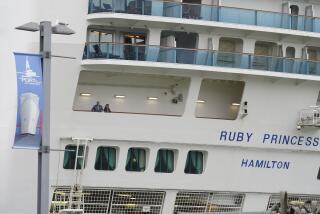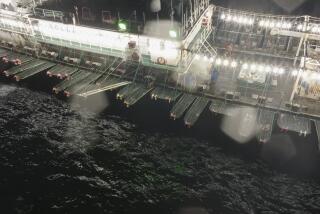Don’t Become ‘Accidental Tourist’ Aboard Ship
- Share via
Quick quiz. The leading reason for cruise passengers to visit the ship’s physician is: a) sunburn, b) seasickness, c) to ask for medications left at home, d) indigestion/overeating or e) accidents on shore?
The answer: medications left at home. Second is sunburn. Next are the various aches, pains and colds that would probably occur even at home.
Seasickness and indigestion/overeating are way down the list. Accidents, while uncommon, are the leading cause of serious problems. Most of the accidents, especially those that are serious, occur on shore, at ports of call.
These findings are the result of a survey of half a dozen cruise physicians. And here are some of their tips for even smoother sailing:
--Bring your medications. Large ships stock most of the more common prescription items. Also, bring medical records if you have an on-going medical condition. In case of a problem, you can call your physician from most ships.
--Forget about tanning and worry about burning. Since most cruises sail the tropics, there are more hours of sunlight and the intensity is increased since the rays reflect off the water. During the winter, if you come from a dark, northern climate, you may be especially vulnerable to burning since your skin has lost any protection from the previous summer’s sun exposure.
To protect yourself, cover up instead of peeling down. Wear loose-fitting, tightly woven, dark-colored cotton garments. These will probably have a sun protection factor (SPF) of more than 1,000, allowing through only 0.1% of the ultraviolet light. A loosely-knitted nylon jersey has an SPF of about 4, which allows 24% of the ultraviolet light through.
Use ample and appropriate sunscreen. And wear a hat with a broad brim and sunglasses.
--Mishaps aboard ship are rare but do occur. Wear comfortable, low-heel, slip-proof shoes. Decks are slippery when wet, and gangways may slope. Watch for bulkheads in passageways.
--Leave a light burning in your cabin to avoid accidents. Leave floors clear of objects, mind the storm step between cabin and bathroom, hold on to safety grips when showering, and, in storms, keep fingers out of doorways. The movement of the ship can slam doors shut.
--Drink sensibly. Many shipboard mishaps are alcohol-related. Some ships have Alcoholics Anonymous meetings available for passengers.
On cruises, it is the ship that is the haven, not the ports, says Dr. Ian Reid Entwhistle, former medical superintendent of the Cunard Line and once the medical officer of the Queen Mary, Queen Elizabeth and the QE2.
Embarking and disembarking from ship’s launches can be a “hazardous pastime, particularly if the ship is anchored in a high swell,” says Entwhistle. Let a crew member assist you, especially to hold packages. If you have difficulty walking, look for itineraries in which the ship pulls up to dockside.
--Think twice about renting cars, bicycle and mopeds. Roads may be bad. Potholes, blind driveways, children and animals darting into the road offer potential for danger. The safest shore excursions are by bus; next safest are by taxi. Mopeds are especially dangerous. Remember, most ports and all cruise ships are poorly equipped to handle major accidents.
--Ask the ship’s physician if food and water are safe on shore. Be wary of outdoor restaurants and buffets. Food must be protected from flies and kept cold. Eat raw seafood only in recommended restaurants. Think twice about buying food from street stalls. Generally, fruits you peel yourself are safest.
If you wish, your waiter will usually prepare box lunches and beverages to take ashore.
Check with the ship’s purser about buying foods to take back home. Some items cannot be imported into the United States and will be confiscated by customs.
--Immunizations and protective medications are recommended for some ports. Physicians stock these. Ideally, however, requests should be made weeks in advance.
--Ask aboard ship about safe places to swim. Some beaches have no lifeguards, are polluted, have strong undertows and may be infested with unfriendly sea creatures. The fact that locals swim there is no assurance of safety.
More to Read
Sign up for The Wild
We’ll help you find the best places to hike, bike and run, as well as the perfect silent spots for meditation and yoga.
You may occasionally receive promotional content from the Los Angeles Times.






